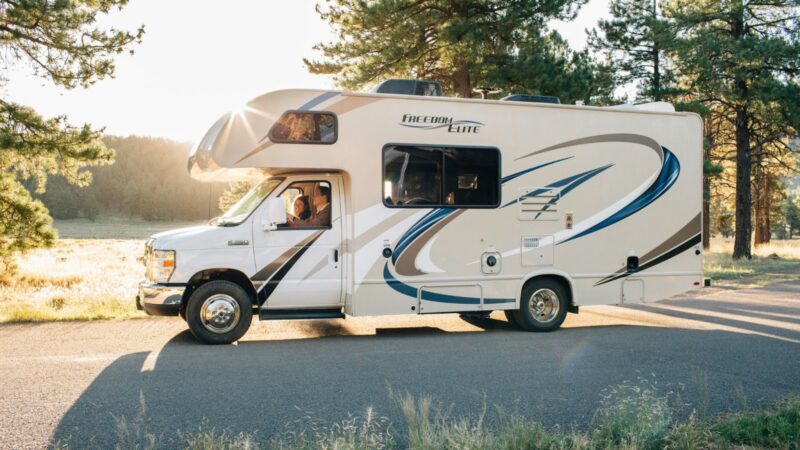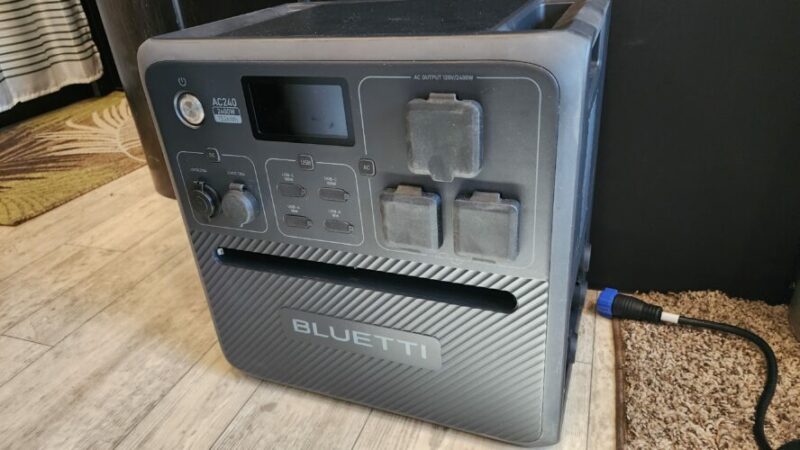8 Tips For Navigating Tight Parking Lots In Your RV

How Do You Navigate Tight Parking Lots In An RV?
Driving an RV is great, and camping in an RV is even better. But parking an RV… not so much. When you’re maneuvering such a large and unwieldy vehicle, it’s easy to get stuck in a tight spot. Every RV owner has a few horror stories about getting pinned in parking lots or being unable to find a place to pull over. But there are ways to overcome these issues.
If you haven’t encountered parking problems yet, you probably will at some point. It’s just part of the lifestyle! But in most cases, you can figure out a solution without causing any damage to your vehicle or the cars around you. Parking will always be tricky but it gets easier with practice. But if this challenge is new to you, we have some helpful tips to help you navigate parking lots.
Tips for navigating tight parking lots
1. Use your backup camera and mirrors
If you’re trying to back into a parking spot or reverse away from a tricky situation, you should use all the tools at your disposal. Most modern RVs have backup cameras installed that will give you a clear view of what’s behind you. Use these to check for obstacles, pedestrians, and cars that may be blocking your path.
Just remember that backup cameras aren’t perfect! They tend to warp the image a bit and they also have blind spots. Use your side mirrors and peek your head out the window to double-check your path.
2. Open your blinds on every window
Another way to improve your visibility is to open up your blinds and curtains. If you’re driving a motorhome, this tactic will help you access additional windows so you can check for obstacles along the sides. The more windows you have, the better you can deal with your surroundings.
Unfortunately, this tactic only works for those who own motorhomes. Otherwise, you’ll need to rely on other sensors and mirrors. Installing side view cameras can achieve a similar effect, though!
3. Remove extra length
This is another tip that only works in specific scenarios, but it can sometimes help you deal with tight parking lots. The longer your RV is, the harder it is to park. You can get stuck in a bad situation if your rig gets out of control. But sometimes you can shed some extra length to make it easier to park.
For instance, if you tow an extra vehicle behind a motorhome, you can disconnect this piece before you find a parking lot. Or, if you find yourself in a situation where it’s hard to turn around, you may want to unhook your tow vehicle from the travel trailer, reposition yourself, then reconnect again. This requires extra time and patience, but it may be necessary.
4. Have someone get out and guide you
Mirrors and cameras are wonderful tools, but there’s no substitute for a real person guiding your actions. Parking an RV can be incredibly stressful, and it’s easy to make mistakes if you can’t see what you’re doing. That’s why a person on the ground can be a major help.
If you’re preparing to park in a difficult lot, have one of your passengers get out to assist you. You could also recruit help from a passing stranger if no one else is available! Roll your window down so you can hear them better, or use walkie-talkies. With a bit of outside help, you should be able to park much more easily.
5. Use cones as goalposts
Parking guidelines can sometimes be difficult to see. The paint may be faded, or certain parts may be blocked by shadows. If you can’t see the lines, you won’t be able to align your vehicle and get into the right spot! That’s why it’s a good idea to travel with some small cones or road markers.
Place these along the guidelines and keep them as straight as you can. Physical objects like this will be much more visible from your RV. Now you can line up your rig more easily and move it into the proper position.
6. Always go slow
This is good general advice for any parking lot, but be sure to take your time and move slowly. Hurrying can always lead to disaster! There may be frustrated drivers around you, but they’ll have to recognize that you’re driving a big rig and it’s going to take time to park it. Try not to let anyone rush you.
7. Don’t be afraid to ask for help
Sometimes a parking lot can be too much to handle. Not every RVer has the right experience or skills to get out of a tricky situation. I’ve gotten stuck more than once, and it’s never a fun time. But when things like this happen, the people around you are usually willing to help.
Other people might be able to move their cars or give you helpful advice on how to navigate the tight parking lot. In some cases, they might be able to hop in and maneuver the RV themselves! Of course, you should be careful about who you allow to handle your rig, but I’ve been able to get out of tight spots by letting someone else take the wheel for a couple of minutes.
8. Find a different parking lot if necessary
Finally, you need to know when to quit. Sometimes a parking lot just isn’t designed for RVs. The parking spaces may be too short or too close together. Plus, even if you manage to park, backing out and turning around can be a nightmare.
Sometimes you’ll need to cut your losses and search for a new place to pull in. Keep an eye out for semi-trucks, buses, and other RVs if you want to find a spot that has appropriate parking for big rigs.
Preventative tactics for RV parking
Once you’re in a parking lot, you should follow the tips above to navigate that situation. But there are a few things you can do to hone your parking skills and make the whole process easier on yourself. Try these preventative tactics to avoid a disaster next time you travel!
Understand the differences between RVs and cars
At the end of the day, cars and RVs handle quite differently. You’ll need to be aware of these differences so you can prepare for driving and parking. One major factor is size. Even the smallest RVs are around 25 feet long, which is larger than the standard parking space. You’ll need to account for this extra length as well as the wider turn radius.
Travel trailers, fifth wheels, and other towable RVs introduce a new problem as well. When you try to back up in one direction, they usually want to go the other way. This can result in unintended swinging, and you might even back into your own RV.
Know your RV measurements
As you travel and look for appropriate parking spots, you should know your RV’s specific measurements. If you don’t remember them off the top of your head, write them down and keep the note within easy reach of the driver’s seat. That way, you won’t be surprised by low clearance areas or particularly narrow parking spaces.
Practice parking in safe locations
Another way to protect yourself is to practice parking. Everyone gets better with practice, so don’t leave for a trip until you’re comfortable handling the RV. Go to an empty street or parking lot to practice your skills. Set up some cones and rehearse how to get in and out of a spot.
You might even simulate parallel parking with cones as well! This skill is much harder, though, and it’s understandable if you want to avoid it entirely and just look for a new spot.
Research the parking situation ahead of time
Finally, you can make things easier on yourself by learning about the parking options before you arrive. Some places have large lots that are easy to navigate. Others are more limited, so you may want to find another place to park while you walk the remaining distance. A bit of research can go a long way!
For all of your camping and trip planning needs, look no further than RV LIFE Campgrounds and RV LIFE Trip Wizard. Campground Reviews is a trusted source of campground and RV park reviews offered by camping and RV enthusiasts just like you. With its accompanying RV LIFE App, RV Trip Wizard gets you to your camping destinations utilizing RV-friendly routes specific to your RV and travel preferences.
Related articles:
- The 12 Best Parallel Parking Tips For RVers
- How To Handle And Drive Your RV Like A Pro
- The Etiquette Of Not Parking Too Close
The post 8 Tips For Navigating Tight Parking Lots In Your RV appeared first on RV LIFE.






